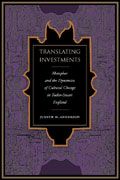Translating Investments
Metaphor and the Dynamics of Cultural Change in Tudor-Stuart England

The title Translating Investments, a manifold pun, refers to metaphor and clothing, authority and interest, and trading and finance. Translation, Latin translatio, is historically a name for metaphor, and investment, etymologically a reference to clothing, participates both in the complex symbolism of early modern dress and in the cloth trade of the period. In this original and wide-ranging book, Judith Anderson studies the functioning of metaphor as a constructive force within language, religious doctrine and politics, literature, rhetoric, and economics during the reigns of the Tudors and early Stuarts. Invoking a provocative metaphorical concept from Andy Clark's version of cognitive science, she construes metaphor itself as a form of scaffolding fundamental to human culture. A more traditional and controversial conception of such scaffolding is known as sublation-Hegel's Aufhebung, or "raising," as the philosophers Jacques Derrida and Paul Ricoeur have understood this term. Metaphor is the agent of raising, or sublation, and sublation is inseparable from the productive life of metaphor, as distinct in its death in code or cliché. At the same time, metaphor embodies the sense both of partial loss and of continuity, or preservation, also conveyed by the term Aufhebung.
Anderson's study is simultaneously critical and historical. History and the theory are shown to be mutually enlightening, as are a wide variety of early modern texts and their specific cultural contexts. From beginning to end, this study touches the present, engaging questions about language, rhetoric, and reading within post-structuralism and neo-cognitivism. It highlights connections between intellectual problems active in our own culture and those evident in the earlier texts, controversies, and crises Anderson analyzes. In this way, the study is bifocal, like metaphor itself.
While Anderson's overarching concern is with metaphor as a creative exchange, a source of code-breaking conceptual power, each of her chapters focuses on a different but related issue and cultural sector. Foci include the basic conditions of linguistic meaning in the early modern period, instantiated by Shakespeare's plays and related to modern theories of metaphor; the role of metaphor in the words of eucharistic institution under Archbishop Cranmer; the play of metaphor and metonymy in the writings of Luther, Zwingli, and Calvin and in John Donne's Devotions; the manipulation of these two tropes in the politics of the controversy over ecclesiastical vestments and in its treatment by John Foxe; the abuse of figuration in the house of Edmund Spenser's Busirane, where catachresis, an extreme form of metaphor, is the trope du jour; the conception of metaphor in the Roman rhetorics and their legacy in the sixteenth century; and the concept of exchange in the economic writing of Gerrard de Malynes, merchant and metaphorist in the reigns of Elizabeth and James. What emerges at the end of this book is a heightened critical sense of the dynamic of metaphor in cultural history.
...is a complex, eloquent account of the peculiar blend of human ingenuity and impulse behind metaphor——The Spenser Review
A learned and ambitious book . . .——Sidney Journal
In a scholarly study that is at once critical and historical, Anderson (Indiana Univ.) explores "the functioning of metaphor in Tudor and early Stuart culture." The author has presented much of this in various forums, but she adds some new material in bringing her work together in one book. Linking diverse disciplines and combining wide scope and micromanagement of topics, she sets up each chapter with a different focus. She is fearless in wrestling with arcane topics such as the Ricoeur-Derrida debates over metaphor, Spenserian allegory, Ciceronian rhetoric, and Gerald de Malynes' ideas on market economies. This results in a collection that will overwhelm uninitiated readers, who will stagger under the dense prose with its long sentences, overabundance of prepositional phrases, and polysyllabic words, but it will delight specialists who will appreciate Anderson's well-documented, detailed research and extensive apparatus. In the end, curious and determined readers will agree that Anderson achieves her aim of exploring the "dynamic of metaphor in cultural history" and how metaphor can "be powerfully and validly constructive." Summing Up: Recommended. Graduate and research collections only.——Choice
Anderson's meditations are approached through the mediations of multiple translations, the workings of creative metaphor with its own complex relationship to constricting metonomy.——Seventeenth-Century News
...a fine sense of metaphor as a cultural project across an especially broad range of terrain in early modern England.——Renaissance Quarterly
This is a rich, densely-written book, working in a bravura variety of fields and full of shrew insight.——Shakespeare Quarterly
Thoroughly grounded in the history of metaphor, from classical and medieval times through Paul Ricoeur, Derrida, and others, Anderson's book will be important to anyone interested in metaphor, in any field.——Studies in English Literature

